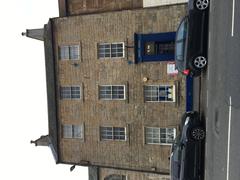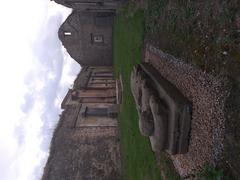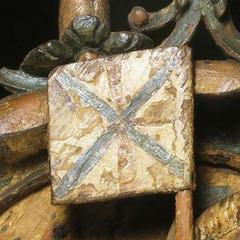Auldcathie Church: Visiting Hours, Tickets, and Historical Guide in Livingston, United Kingdom
Date: 14/06/2025
Introduction
Set within the tranquil landscapes near Livingston in West Lothian, Scotland, Auldcathie Church is a remarkable medieval ruin offering a vivid window into the region’s deep ecclesiastical and community heritage. Dating back to the 12th century, this scheduled ancient monument has witnessed centuries of religious, architectural, and social change—from its origins as a private chapel to its role as a parish church and eventual abandonment after the Scottish Reformation. Today, Auldcathie’s evocative sandstone remains invite exploration by history enthusiasts, families, and nature lovers alike. With its free, open access and proximity to the newly developed Auldcathie District Park, the site combines historical discovery with scenic recreation.
This comprehensive guide covers visiting hours, ticketing, historical significance, accessibility, and nearby attractions to ensure a rewarding experience for every visitor. (Canmore, Historic Environment Scotland, West Lothian Council)
Table of Contents
- Introduction
- Historical Overview
- Visitor Information
- Frequently Asked Questions (FAQs)
- Conclusion and Travel Tips
- References and Further Reading
Historical Overview
Early Origins and Medieval Foundations
Auldcathie Church traces its foundations to the 12th century, with its earliest recorded mention in 1180. The name “Auldcathie,” meaning “old seat” or “old chair,” is linked to the de Veteri Cathedra family, early patrons of the church (Canmore). Dedicated to St. Catherine, the church reflects the medieval Scottish tradition of venerating female saints.
Built from local sandstone, the original church was a simple rectangular structure. Over time, expansions added a chancel and nave, and by the late 15th century, a distinct bellcote crowned its western gable.
Reformation and Decline
The Scottish Reformation in 1560 brought profound changes. Auldcathie Church shifted from Roman Catholicism to the Church of Scotland, resulting in the removal of Catholic iconography (Historic Environment Scotland). Despite continuing as a local spiritual hub, the church was abandoned by 1618 as parish congregations merged and shifted to newer buildings.
Architectural Features and Archaeological Insights
The ruins stand approximately 3 meters tall, measuring 18 by 6 meters. Key features include:
- Bellcote remains on the western gable
- Piscina in the chancel wall, indicating pre-Reformation liturgical practices
- Aumbry recess and other medieval details (ScotlandsPlaces)
Archaeological studies have revealed medieval burials with intricately carved headstones, offering insights into the church’s enduring community importance.
Role in Local Society and Landownership
Beyond its religious role, Auldcathie Church was a focal point for community life and the burial place of prominent families such as the Dundas and Hamilton clans (West Lothian Council). Its fortunes were closely tied to changes in landownership and rural demographics.
Preservation and Modern Rediscovery
After centuries of decline and stone removal, conservation efforts in the late 20th and 21st centuries stabilized the ruins and enhanced public access. Now a protected scheduled monument, the church features interpretive signage and is integrated with walking trails from Auldcathie District Park (Historic Environment Scotland).
Visitor Information
Visiting Hours
Auldcathie Church is accessible year-round during daylight hours. As an outdoor ruin, there are no official opening or closing times, but visiting during daylight ensures both safety and optimal appreciation of the site.
Tickets and Entry Fees
There are no admission fees or ticket requirements—visitors may freely explore the ruins at any time.
Getting There
- Location: Near Auldcathie District Park, just off the B8020 and within a short drive or cycle from Livingston town centre.
- Parking: Available at the district park.
- Public Transport: Local buses serve the Broxburn and Winchburgh areas, with walking routes from nearby stops.
Accessibility
Paths from the district park to the church are maintained, but the site’s uneven and natural terrain may present challenges for wheelchair users or those with limited mobility.
Guided Tours and Events
While there are no regular guided tours, community groups such as the Friends of Auldcathie occasionally host heritage walks and events. Check the West Lothian Council Events page for updates.
Photographic Opportunities
The church’s atmospheric ruins and rural setting are ideal for photography, especially during golden hour or in spring and autumn when natural light accentuates the stonework.
Site Etiquette and Safety
- Do not climb on the ruins or disturb gravestones.
- Keep pets leashed and respect local wildlife.
- Take care on uneven ground, especially in wet weather.
- Leave no trace—please take litter home.
Nearby Attractions
- Auldcathie District Park: Adjacent to the church, this 78-acre park offers walking and cycling trails, wildflower meadows, a play area, and picnic spots (West Lothian Courier).
- Almond Valley Heritage Centre: A family-friendly museum and working farm, 3 miles away (Almond Valley Heritage Centre).
- Linlithgow Palace: The birthplace of Mary, Queen of Scots, with guided tours and exhibitions (Historic Environment Scotland - Linlithgow Palace).
- The Kelpies and The Helix Park: Iconic horse-head sculptures and parklands, 10 miles northeast (The Kelpies).
- Livingston Designer Outlet: Over 70 stores and eateries, plus a cinema (Livingston Designer Outlet).
- Beecraigs Country Park: 913 acres of woodland, trails, and a deer park (Beecraigs Country Park).
Frequently Asked Questions (FAQs)
Q: What are the visiting hours for Auldcathie Church?
A: The church is open year-round during daylight hours, with no formal opening or closing times.
Q: Is there an admission fee or ticket required?
A: No, entry is free and unticketed.
Q: Are guided tours available?
A: Not regularly, but community groups may occasionally host walks or events. Check local listings.
Q: Is the site wheelchair accessible?
A: The approach path is maintained, but the terrain is uneven and may be challenging for wheelchairs.
Q: Are there facilities on site?
A: No, but Auldcathie District Park nearby offers parking and walking trails. Amenities such as cafés and restrooms are available in Winchburgh and Livingston.
Q: Can I bring my dog?
A: Yes, provided dogs are kept on a leash.
Conclusion and Travel Tips
Auldcathie Church stands as a vital link to Scotland’s medieval heritage and the social history of West Lothian. Its evocative ruins, set amidst tranquil parkland, provide a unique destination for those interested in history, architecture, or outdoor recreation. With free access and proximity to a wealth of nearby attractions, Auldcathie Church is a highlight among Livingston historical sites.
Travel Tips:
- Dress for the weather and wear sturdy footwear.
- Bring snacks and water, as there are no onsite facilities.
- Combine your visit with a walk in Auldcathie District Park or a trip to nearby heritage attractions.
- Download the Audiala app for interactive tours and up-to-date information on events and heritage sites throughout West Lothian.
For additional resources and the latest updates, visit:
References and Further Reading
- Auldcathie Church Visiting Hours, Tickets, and Historical Guide in Livingston, 2025, West Lothian Council
- Auldcathie Church: Visiting Hours, History & Architectural Highlights in West Lothian, 2025, PKWLA
- Visiting Auldcathie Church: History, Heritage, and Community in West Lothian, 2025, Historic Environment Scotland
- Auldcathie Church Visiting Hours, Tickets, and Nearby Attractions: A Guide to Livingston Historical Sites, 2025, West Lothian Courier
- Canmore: Auldcathie Church Site Record, 2025
- Historic Environment Scotland: Auldcathie Church Scheduled Monument, 2025
- Undiscovered Scotland: Auldcathie Church, 2025
- Corpus of Scottish Medieval Parish Churches
- PKWLA: Our Parishes
- UK Genealogy Archives: Dalmeny Parish
- Winchburgh Developments
- Mapcarta
- Met Office
Plan your visit to Auldcathie Church today and uncover the layered stories, serene beauty, and vibrant community spirit that make it a treasured part of Livingston’s historical landscape.


